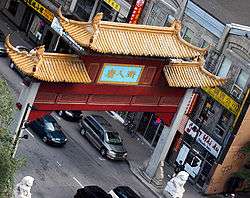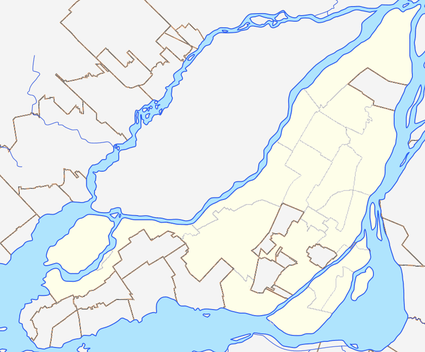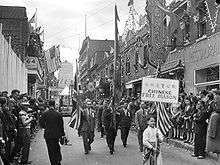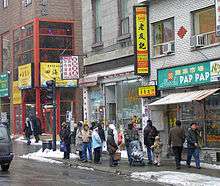Chinatown, Montreal
Chinatown in Montreal (French: Le quartier chinois de Montréal; simplified Chinese: 蒙特利尔唐人街; traditional Chinese: 蒙特利爾唐人街; pinyin: Méngtèlì'ěr Tángrénjiē) is located in the area of De la Gauchetière Street in Montreal. The neighbourhood contains many Asian restaurants, food markets, and convenience stores as well being home to many of Montreal's East Asian community centres, such as the Montreal Chinese Hospital and the Montreal Chinese Community and Cultural Center. CHUM Hospital is located in Chinatown.[1]
Chinatown Quartier Chinois | |
|---|---|
 The paifang on Saint Laurent Boulevard | |
 Chinatown Location of Chinatown in Montreal | |
| Coordinates: 45.50759°N 73.5608°W | |
| Country | Canada |
| Province | Quebec |
| City | Montreal |
| Borough | Ville-Marie |
| Established | 1877 |
| Elevation | 70 ft (20 m) |
History



Origins
The area was once home to Montreal's Jewish community, with thousands of Yiddish speaking immigrants settling in the area from 1890 to 1920, as part of a Jewish quarter centred on Saint Laurent Boulevard.[2]
The first Chinese immigrants to Montreal arrived in March 1877. The first Chinese that created Montreal's Chinatown belonged to the Chan, Hom (Tam), Lee, and Wong clan groups.[3][4] Many Taishan Chinese settled (all following the Leung Family) in the area because they worked for the railways and it was convenient for these occupations.
Among the first Chinese residents was Jos Song Long who opened a laundromat on Craig Street (today Saint Antoine Street).[5] Most Chinese residents were primarily Cantonese-speaking and had moved from British Columbia and southern China to what had been a primarily residential area.[6] Initially, many Chinese Montrealers ran laundromats, as owning their own businesses allowed them to avoid the pay discrimination that they had faced in British Columbia. Businesses such as laundromats required geographic proximity to its customers, and as a result, this type of business became quite common in Montreal, with Chinatown being largely commercially oriented.
In 1902, the area officially became known as "Chinatown", and specifically referred to several blocks centered on De La Gauchetière Street between Chenneville and Clark Streets. On these streets, many Chinese-owned businesses opened, notably restaurants and specialty grocers.[6] The neighbourhood was strategically located with modest-sized lots, affordable rents and close proximity to Saint-Laurent Boulevard, which attracted non-Chinese clients.[7]
Over the years, Hong Kong Chinese and ethnic Chinese refugees from Vietnam also set up shops and restaurants in the area.
Decline
From the 1970s onwards Montreal's Chinatown was subject to many of the cities' redevelopment plans, reducing the size of Chinatown and its expansion.[3] This saw to the expropriation and demolition of over 6 acres of private properties in the construction of the Complexe Guy-Favreau and a city block of Chinatown for the construction of Palais des congrès de Montréal, even as community consultation and negotiations were still on-going.[3][4] Rezoning of areas east of Saint Laurent from Chinatown in the 1980s has further prevented the growth expansion of Chinatown businesses.
Features
Much of Montreal Chinatown is located on La Gauchetière Street and around Saint Urbain Street and Saint Lawrence Boulevard (boul. Saint-Laurent), between René Lévesque Boulevard and Viger Avenue (Place-d'Armes Montreal metro station), occupying roughly the area of a city block. The part of La Gauchetière that crosses through Chinatown is a pedestrian walkway, making it more inviting for a stroll. On several weekends during the summer, the street becomes a lively outdoor fair. Prior to 1970, a significant part of Chinatown extended west to Jeannes-Mance Street.
Montreal has the most paifang of any Chinatown in Canada, with 4 gates in the:
- North: 45.508695°N 73.561272°W
- South: 45.507597°N 73.558842°W
- East: 45.508441°N 73.559692°W
- West: 45.505324°N 73.561908°W
Montreal's Chinatown is a vibrant nightspot for locals and tourists alike thanks to a special regulation by Montreal's city officials which slates the sector as a tourist area, thus allowing it to continue operations well into the evening. Cantonese seafood, barbecue and dim sum restaurants and Vietnamese Phở eateries are featured in Chinatown. Many local Asian-Canadians frequent the area since the shops offer products directly imported from Mainland China or Vietnam that are difficult to find elsewhere in town.
Aside from its economic importance in the sector, Montreal's Chinatown actively participate in numerous community activities. The offices of many Chinese newspapers, organizations and associations are located in the surrounding buildings. Moreover, the Chinatown houses the biggest Chinese school of Montreal (over 1500 students) as well as the Montreal Chinese Catholic Mission. Over the years, the Canadian government has continually sought to invest in the area by funding the construction of the Montreal Chinese Hospital and the Montreal Chinese Cultural and Community Center.
Like many other Chinatowns, Montreal also has the annual Miss Chinese Montreal Pageant, where the winner goes on to compete at the Miss Chinese International Pageant, which is usually held in Hong Kong or in mainland China.
Media
| Chinatown, Montreal | |||||||||||||||
|---|---|---|---|---|---|---|---|---|---|---|---|---|---|---|---|
| Chinese name | |||||||||||||||
| Traditional Chinese | 蒙特利爾唐人街 | ||||||||||||||
| Simplified Chinese | 蒙特利尔唐人街 | ||||||||||||||
| |||||||||||||||
| Alternative Chinese name | |||||||||||||||
| Traditional Chinese | 蒙特利爾華埠 | ||||||||||||||
| Simplified Chinese | 蒙特利尔华埠 | ||||||||||||||
| |||||||||||||||
| Second alternative Chinese name | |||||||||||||||
| Traditional Chinese | 滿地可華埠 | ||||||||||||||
| Simplified Chinese | 满地可华埠 | ||||||||||||||
| |||||||||||||||
| French name | |||||||||||||||
| French | Le quartier chinois de Montréal | ||||||||||||||
Chinatown was the filming location of the 2008 film release Punisher: War Zone. Some parts of Chinatown were redressed with English-language signage to recreate the atmosphere of Chinatown, Manhattan.
There are Four Chinese language weekly newspapers operating in Montreal: La Grande Époque Montréal, Les Presses Chinoises, Sept Days, and the Luby.
Other Chinese areas
Chinatown West
A new Chinatown has begun to develop in the area west of Concordia University in the last fifteen years, particularly along Sainte Catherine Street between Guy Street and Atwater Avenue. It caters primarily to the growing mainland Chinese and East Asian student and immigrant population in the area.[8][9] As of 2006, 22.9% of the area's population were of Chinese origin.[10] The area is commonly known as the "Concordia Ghetto", similar to the "McGill Ghetto" found in Milton Parc, a student neighborhood located directly east of McGill.
Brossard
Various Asian-themed malls have arisen along Taschereau Boulevard in the south shore suburb of Brossard, where a significant portion of the population is of Chinese origin. The provincial government of Quebec enticed Hong Kong millionaires to settle and invest in the province, particularly in Brossard. The shopping centres were largely funded by Hong Kong Chinese immigrant investors, some of whom have since returned to Hong Kong or have relocated to larger Chinese immigrant centres such as Toronto and Vancouver. A wide range of Chinese restaurants, grocers, and services can still be found in Brossard.
- Place Kim Phat
Gallery
 A bus stop located along Saint-Laurent Boulevard in Chinatown.
A bus stop located along Saint-Laurent Boulevard in Chinatown.- Holiday Inn hotel in Chinatown
- The guardian lions at the paifang
References
- "Montreal Chinese Cultural Community Centre". Archived from the original on 2 February 2011. Retrieved 13 January 2011.
- deWolf, Chris (28 January 2008). "When Chinatown was a Jewish neighbourhood". Spacing Montreal. Archived from the original on 6 February 2009. Retrieved 10 November 2008.
- Yee, Paul (2005), Chinatown: An illustrated history of the Chinese Communities of Victoria, Vancouver, Calgary, Winnipeg, Toronto, Ottawa, Montreal and Halifax, Toronto, ON, CAN: James Lorimer & Company Limited
- GRAVENOR, KRISTIAN (2005-09-08), "Chinatown whispers", The Mirror, 21 (12)
- Helly, Denise (1987). Les Chinois à Montréal 1877-1951 (in French). Quebec: Institut québécois de recherche sur la culture. p. 66. ISBN 9782892240849. Retrieved 6 October 2018.
- "Immigrant voices". Archived from the original on 2011-08-30. Retrieved 2018-10-06.
- Berson, Alban (June 2018). "La Fondation du quartier chinois de Montréal : une cité sans femmes" (PDF). À rayons ouverts (in French): 10–11. ISSN 0835-8672. Retrieved 6 October 2018.
- Sam, Cédric (2009-04-14). "Montreal's other Chinatown in 2009". Spacing Montreal. Archived from the original on 22 November 2011. Retrieved 13 August 2009.
- DeWolf, Christopher (2007-02-07). "A New "Chinatown" Grows in Montreal". Urbanphoto.net. Retrieved 13 August 2009.
- "Canada 2006 Census – Census tract profile for 0065.01 (CT), Montréal (CMA)and Quebec". www12.statcan.ca. Retrieved 11 August 2017.
External links
| Wikimedia Commons has media related to Chinatown, Montreal. |